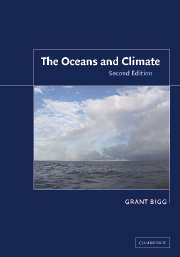Book contents
- Frontmatter
- Contents
- Preface to the first edition
- 1 The climate system
- 2 Physical interaction between the ocean and atmosphere
- 3 Chemical interaction of the atmosphere and ocean
- 4 Biogeochemical interaction of the atmosphere and ocean
- 5 Large-scale air–sea interaction
- 6 The ocean and natural climatic variability
- 7 The ocean and climatic change
- Appendices
- Glossary
- Bibliography
- Index
- References
2 - Physical interaction between the ocean and atmosphere
Published online by Cambridge University Press: 05 June 2012
- Frontmatter
- Contents
- Preface to the first edition
- 1 The climate system
- 2 Physical interaction between the ocean and atmosphere
- 3 Chemical interaction of the atmosphere and ocean
- 4 Biogeochemical interaction of the atmosphere and ocean
- 5 Large-scale air–sea interaction
- 6 The ocean and natural climatic variability
- 7 The ocean and climatic change
- Appendices
- Glossary
- Bibliography
- Index
- References
Summary
The ocean and the atmosphere share a common boundary: the air–sea interface. This direct physical contact enables the two fluids to exchange energy and matter. In this chapter we will examine these exchanges from a physical perspective, leaving a discussion of the chemical controls on matter, particularly gas, transfer to Chapter 3.
Physical interaction between air and sea takes a number of forms. We are all familiar with the production of waves on water, due to wind blowing across the surface. We have also all seen that strong winds tend to force these waves to break, creating whitecaps. When these whitecaps disintegrate, salt water is sprayed into the atmosphere. The addition of fresh water to the ocean through precipitation is another obvious link between the two media.
There are also a number of less obvious interactions. The ocean is given energy by solar radiation passing through the atmosphere. Infra-red radiation from within the atmosphere enters the ocean; it also leaves the ocean to warm the atmosphere. There are also other mechanisms for heat exchange. The direct physical contact of the sea and air means that there is exchange of energy through collision of molecules in the surface layer of each fluid. This energy is known as sensible heat. There will also be an exchange of the molecules themselves, generally resulting in net evaporation, and therefore transfer of latent heat, from the water surface.
- Type
- Chapter
- Information
- The Oceans and Climate , pp. 35 - 90Publisher: Cambridge University PressPrint publication year: 2003



